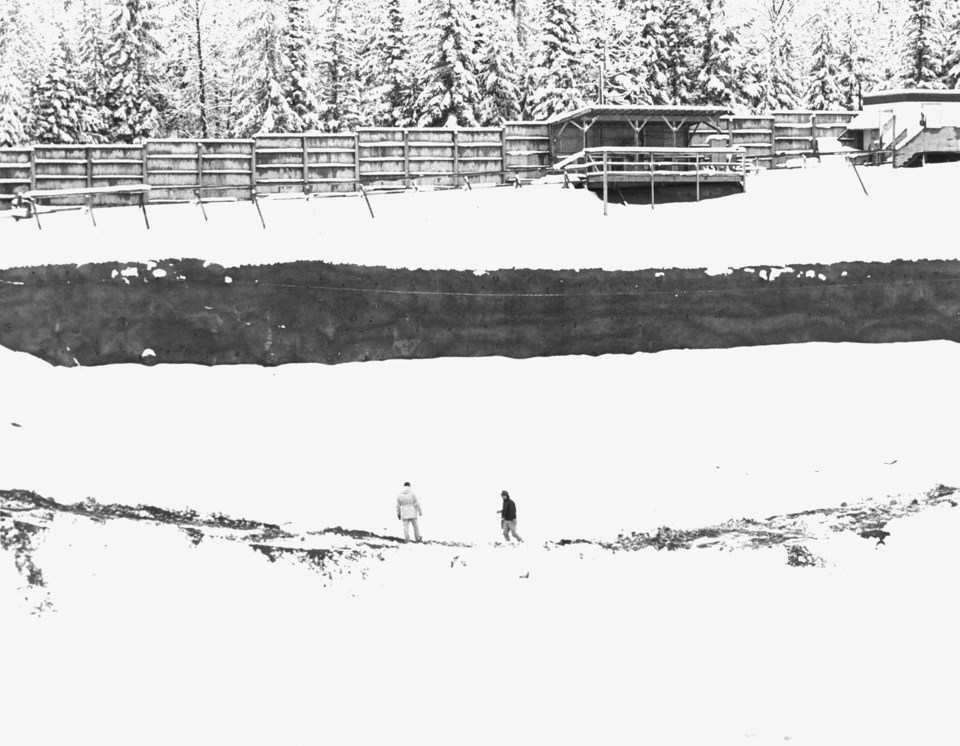In the early 1990s, Larco Investments Ltd. had grand plans for its lot in Whistler Village. The lot, which at the time had been serving as a parking lot for skiers and visitors, was often referred to locally as the Keg Lot, as it was located next to the building that houses the Keg restaurant. Unfortunately, over the summer of 1993, it also became known as the Keg Lot Hole.
Larco’s original plans for the Keg Lot featured a “bowling and condominium hotel complex,” including three levels of parking, a 24- to 34-lane bowling alley, health and fitness spa, car wash for the use of guests, commercial spaces, a restaurant, and, of course, guest accommodations. All this was to be built over two phases, with the first phase completed by May 1994.
Despite a few hiccups concerning a related building permit, the excavation of the Keg Lot was well underway in July 1993. In order to provide the required 650 parking stalls and other underground spaces, a very large hole was dug. According to one report in the Whistler Question, the lot looked “like the set for a science fiction film,” with an impressively large crater surrounded by “miles” of plywood panelling. In an effort to make the plywood walls more attractive, Marion Harding of the Shepard Gallery and the Whistler Community Arts Council (now known as Arts Whistler) called on residents and visitors alike to decorate the boards. Established and aspiring artists were told they could paint whatever they liked, while being reminded that the panels would be seen by all ages.
Rumours and suggestions of problems at the Keg Lot began to circulate not long after the lot was excavated, centring on the Ministry of Environment’s unexpected requirement that a $2.7-million water basin be constructed below the bowling alley. The unforeseen cost led Larco to begin negotiating concessions with the Resort Municipality of Whistler (RMOW), asking that it take over construction of part of the parking structure or eliminate some parking stalls, as well as for concessions on the buildings’ design requirements. The municipality did not agree to Larco’s demands, pointing out that taxpayers could not be on the hook every time something went wrong with a development. On Aug. 4, 1993, Larco announced that it was temporarily halting the project until an agreement could be reached. By the next week, it was accepted that the hole would remain as it was until at least the next spring. This presented various problems: the RMOW had begun work on Village Gate Boulevard that depended on the work on the Keg Lot going ahead; the village area was down a parking lot; and the lot (while not the first hole to be left in the village) was considered unsightly.
While work was stopped on the lot, the artwork on the panels surrounding the Keg Lot continued to grow. By mid-August, about 40 of the 117 panels had already been painted and only six panels were still up for grabs. The subject matter varied: next to the North Shore Credit Union (now BlueShore Financial) was a four-panel rant; outside the Val d’Isere Restaurant (now 21 Steps) a panel featured psychedelically splattered trees; a visiting family from Seattle created a panoramic mountain scene; a local five-year-old enlisted her family to help paint tulips; and artist Matthew Bankert entitled his piece “Post-Apocalyptic Corn.” By September, it was estimated that more than 400 people had worked on the panels. A panel of judges awarded top prizes to Melisa Hardy, for her creation “Woman and a Cat,” and Lauren Collins (Children Under 12) for “Horses and Picket Fence.”
Construction on the Keg Lot restarted in April 1994, and by the next year there was no longer a large hole. The Whistler Village Centre Holiday Inn held a soft opening in March 1995, with the Hard Rock Cafe and a bowling alley expected to follow later that year.




